Review of the best types and varieties of clematis
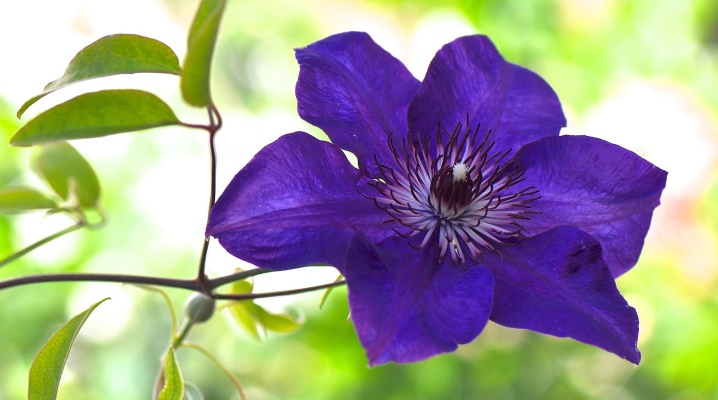
Clematis or clematis are flowering plants that are very popular in the field of landscape design. Climbing vines or compact bushes can decorate a hedge, transform the appearance of an arch or a gazebo. The number of species and varieties of clematis is amazing - dozens of them already exist, and breeders continue to delight fans with new successes.
The size and shape of the bud also matter. It is enough to consider a detailed description of small-flowered white, burning and other types of clematis and it will become clear that this plant definitely deserves the closest attention of gardeners.
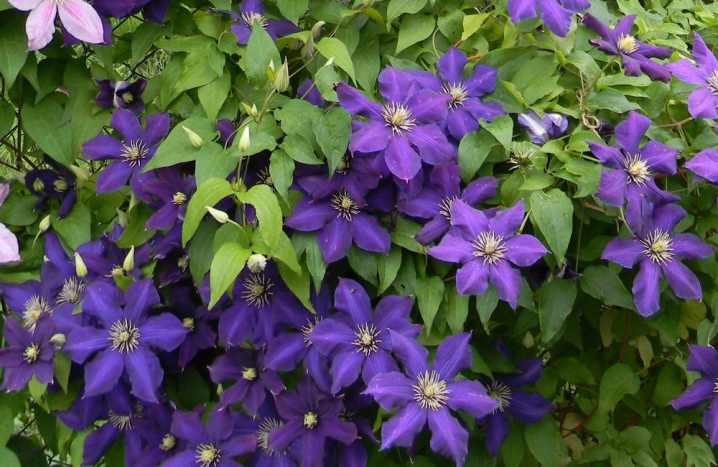
Poetic names are another distinctive feature of clematis. "White Cloud" and "Alyonushka", "Asao" and other varieties not only decorate the site, but also create a special atmosphere in its space. Caring for clematis is simple, they grow easily and quickly, they love sunny areas and perfectly tolerate the vagaries of the weather. You can easily appreciate their attractiveness during the flowering period, when bright buds appear among the lush greenery.

Variety of shades
Lomonosov is diverse not only in the shape and size of the flower. Their color range is also as wide as possible and allows you to find optimal color solutions for gardens, parks and picturesque corners of outdoor recreation. Luxurious curly vines are blue, red, burgundy, purple, pink-purple and lilac.
However, even modest white flowers can look very decorative and elegant. Varieties that produce buds from late spring to mid-autumn are especially appreciated. Shrub species with small white flowers look good in hedges.
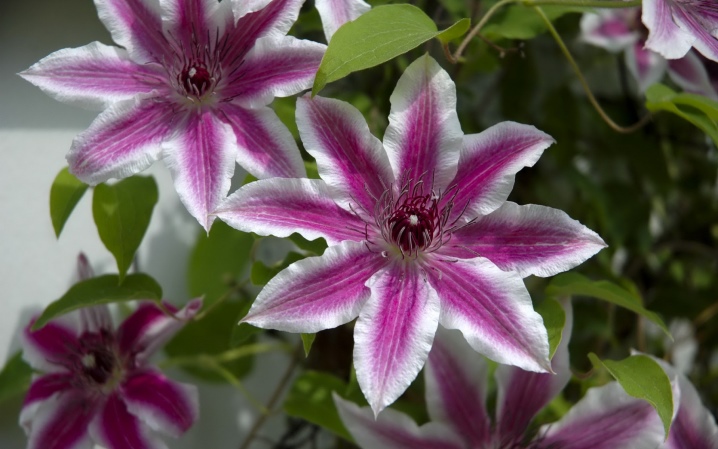
It is worth paying attention to the fact that the brightness of the color of the plant is largely influenced by the conditions of its growth. In climates with little sun, high humidity, low cloudiness, clematis will look faded. In addition, some species are able to change color during the flowering period.
White
A universal choice for a summer residence and a suburban personal plot. The delicate, pure color of the flower looks spring-like cheerful, giving it a special luxury. Among the popular varieties of clematis with pure white buds, the following can be noted.
- "John Paul II". Clematis, bred by Polish breeders, is very resistant to various external factors. The plant is able to winter well without additional shelter, belongs to climbing woody vines, is famous for its long flowering from June to October. The large-flowered variety has sepals of a snow-white shade with a pink stripe in the central part, the stamens are reddish.
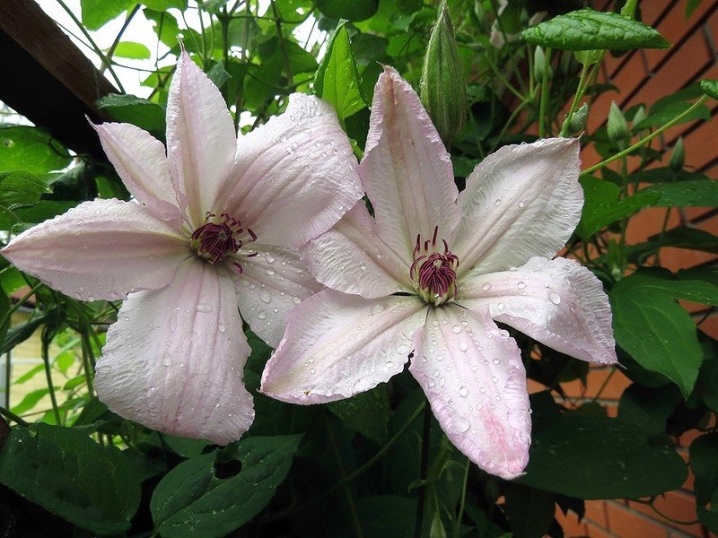
- Arctic Queen. A beautiful multi-flowering variety with large double flowers. White petals are complemented by a yellow anther. This clematis originated in England, where clematis is highly prized. The first flowers appear in June on the shoots of the last year, young shoots cover the plant by August.
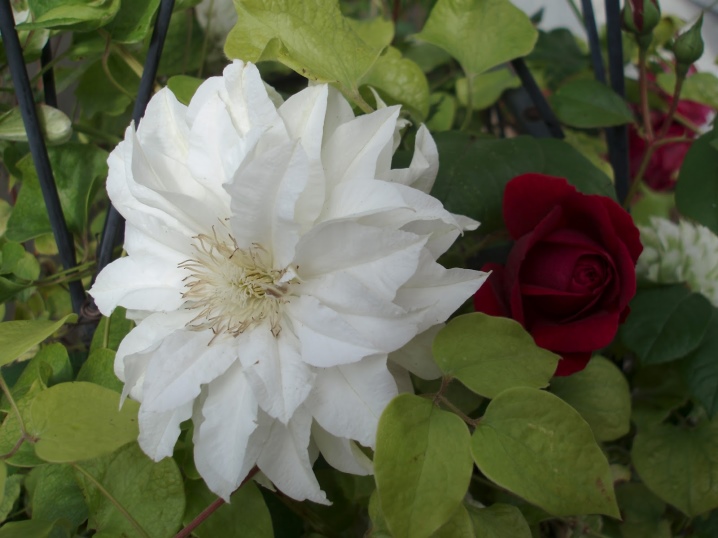
- "Joan of Arc". An unusually beautiful variety of climbing clematis with large, up to 20 cm in diameter, double flowers. Luxurious decoration for gazebos, trellises, hedges, veranda railings.
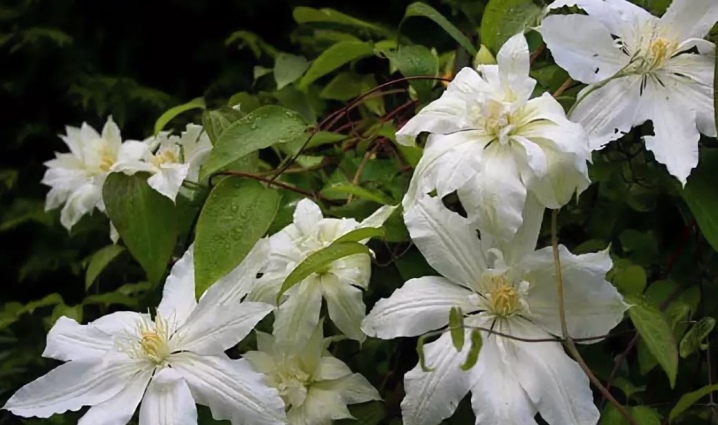
Purple and lilac
Unusual decorative flowers that look especially good when buds are abundant. The simplest in shape is "Victoria" with single-row egg-shaped petals of a rich violet shade with a pink stripe in the center. Looks interesting variety with a bright anther and pale lilac petals "Forest Opera", popular among summer residents "Ideal", "Fantasy" with an average size of inflorescences.
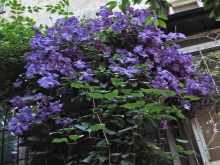
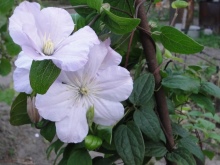
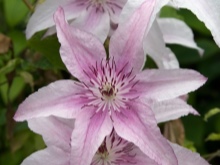
Flowers of a blue-violet hue are also popular. The "Talisman" variety with large bowls and a lush yellow anther looks exquisite at the dacha. The pronounced stripe in the center has a pink-crimson hue.
Reds, purples and burgundy
Clematis of red color are able to decorate with themselves both an ordinary dacha and the luxurious landscape of a city park or a country estate. It is worth noting that they are not found in pure scarlet color, there is always an admixture of purple or burgundy. Shades of red in the case of clematis are quite diverse and allow you to saturate the garden with bright accents; large-flowered varieties can be used in the design of the balcony.
- One of the most beautiful varieties of Allanah red clematis bred in 1968 and is classified as remontant, re-blooming during the season. The climbing plant has shoots up to 3 m long.The inflorescences are stellate, red-crimson, have a diameter of up to 15 cm.
The variety prefers shaded places; in the bright sun it loses its decorative effect.
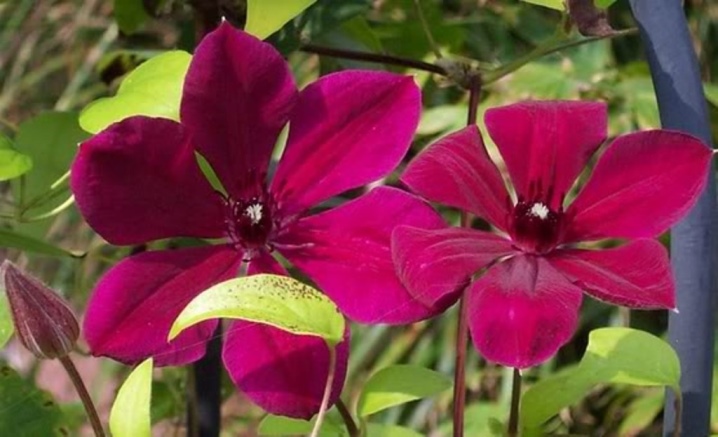
- Ernest Markham also refers to red clematis, although the predominant color in it is crimson. The variety is very popular, bred in England in 1936, flowering continues all summer. Disc-shaped, crimson-red flowers reach 15 cm in diameter.

- Another interesting dark red Monte Cassino variety bred by Polish breeders. It belongs to the category of remontant, it grows up to 2-3 m, flowers are simple, not double, have a disk-like shape.
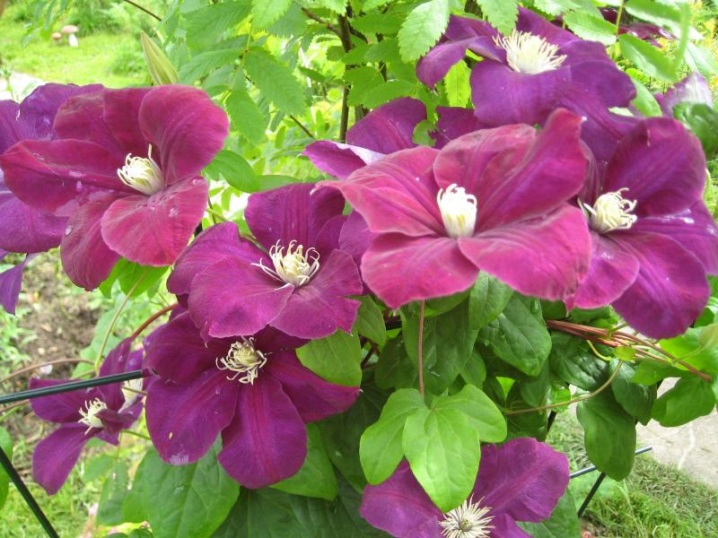
Yellow
Among the most popular types of clematis with a yellow tinge of inflorescences, gardeners distinguish Tangut clematis or tangutika. In the wild, it looks like a shrub with a small shoot height, in cultivated cultivation it shows a tendency to form vines. The flowers of the Tangut clematis have the shape of bells, bending downward, appear on the shoots of the past and current year. Also among the popular varieties with yellow flowers, the following can be distinguished.
- Yellow Queen. Large-flowered variety, liana, capable of climbing high on a trellis or wall of a house. The bud has a silvery-yellow gorgeous shimmer, it looks very impressive. The plant adapts well to growing conditions on balconies (in containers) and outdoors.
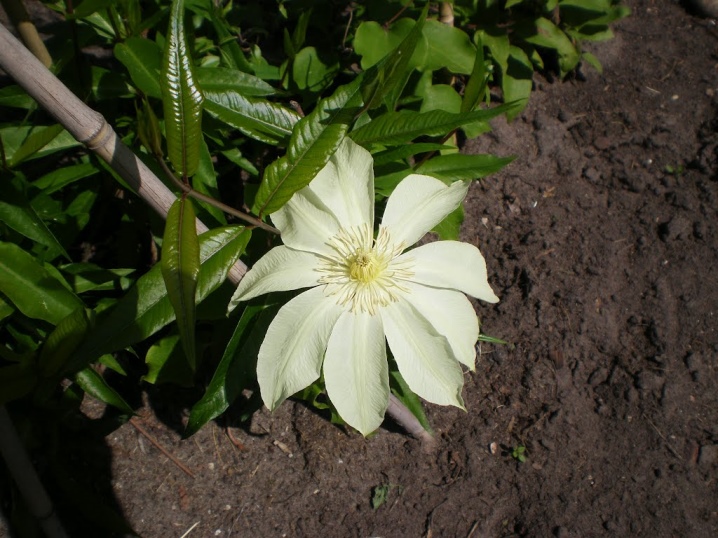
- "Radar of love". Shrub vine with shoots up to 3 m long. The variety belongs to the subspecies of Tangut clematis, its buds are painted in bright yellow color, when closed they resemble bells.
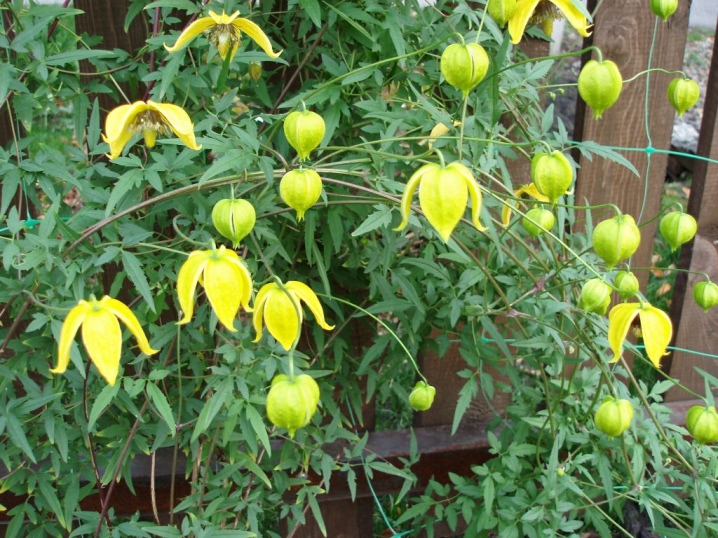
- Golden Tiara. The variety most similar to Tangut clematis, with the same bell-shaped inflorescences, which, when fully expanded, have a crown-shaped shape. It is characterized by the longest flowering, lasting from June to October.
This clematis is quite capricious, sensitive to excess moisture or drought.

Pink
Delicate shades of pink never go out of style. Clematis in this color scheme are often terry, which only enhances their charm. Pink clematis well dilute the usual design of the flower garden and provide vertical landscaping of the site.
Among the most popular varieties can be noted "Josephine" - pink with a lilac undertone and a raspberry strip in the middle, terry, with pompom-type buds. Luxurious large flowers have a diameter of up to 20 cm, their lower petals are fully open, the upper ones are first compressed and only gradually open up. Blooms throughout the summer. The plant has a pronounced aroma.
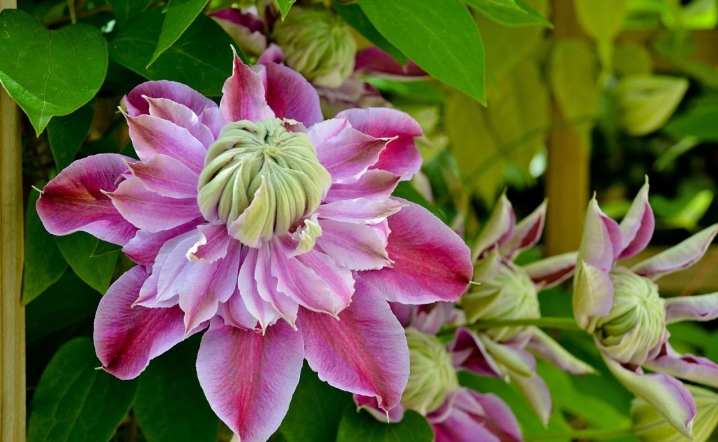
Pink fantasy or "pink fantasy" - a variety of clematis with very delicate pink petals, complemented by a contrasting stroke in the center. The stamens have a bright cherry hue. The variety appeared thanks to Canadian breeders more than 40 years ago. The plant has abundant flowering, lasts from July to September, the climbing stem reaches 3 m.Plants are suitable for growing on balconies, in flowerpots or special containers.
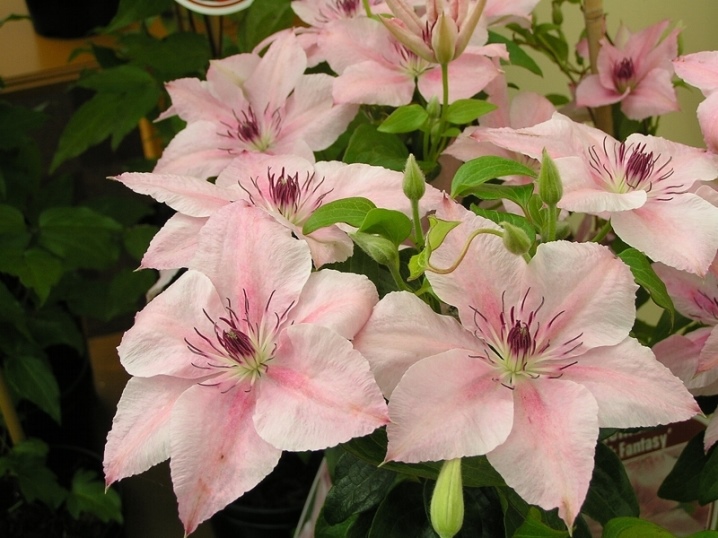
Blue
Amazing, unusual blue flowers against a background of luscious greenery always look very elegant, spectacular and expressive. It should be borne in mind that with a lack of light, ultramarine tones can turn into pale blue, during the season the plant often changes color, turns very pale, or, conversely, picks up colors.
One of the most popular varieties of blue clematis "Biryuzinka" well suited for growing in different climatic zones. Liana grows tall, with shoots up to 3.5 m long. Flowers with yellow stamens have a turquoise color with a lilac-lilac border along the edges of the petals.
The variety is characterized by long flowering.
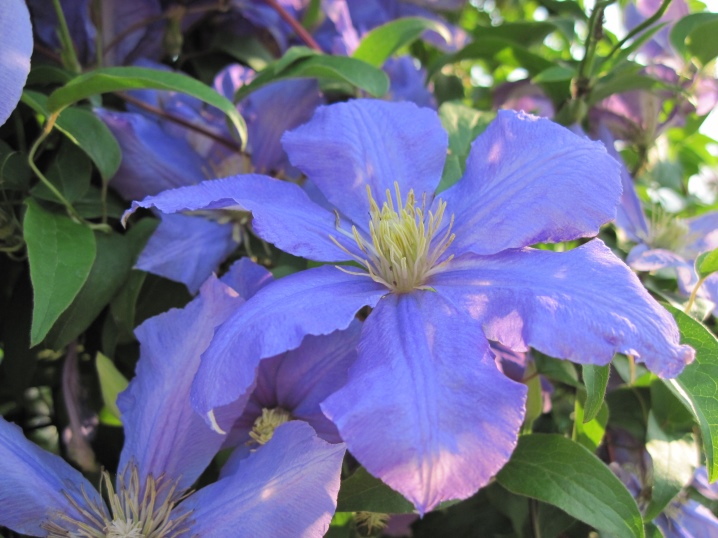
Clematis variety "H. F. Young "- a true decoration of any garden, thanks to the preservation of the shoots of the last year, it provides double flowering. When fully opened, large purple-blue buds form a bowl up to 18 cm in diameter with white stripes and a yellowish anther. The first wave of flowering gives beautiful semi-double inflorescences, the second falls in autumn, and only simple flowers appear in the shoots of the first year.
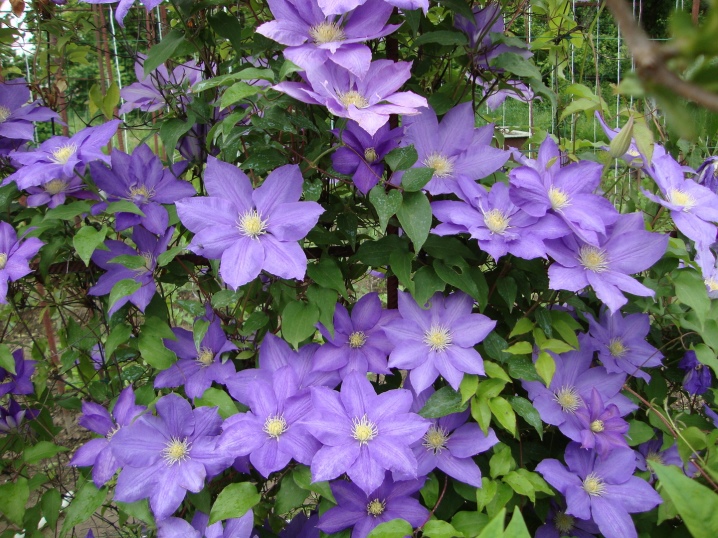
Views
All existing types of clematis can be divided into groups according to the following criteria.
- Flower size. Small-flowered plants are mainly shrubs. Large-flowered and mid-flowered varieties are usually represented by vines.
- Bowl type. It can be simple (with one row of petals), semi-double (with 2-3 circles of parallel sepals) and double (with a large number of rows).
- Stem type. It can be straight, bushy (short or elongated), in the form of a liana, herbaceous and tree-like.
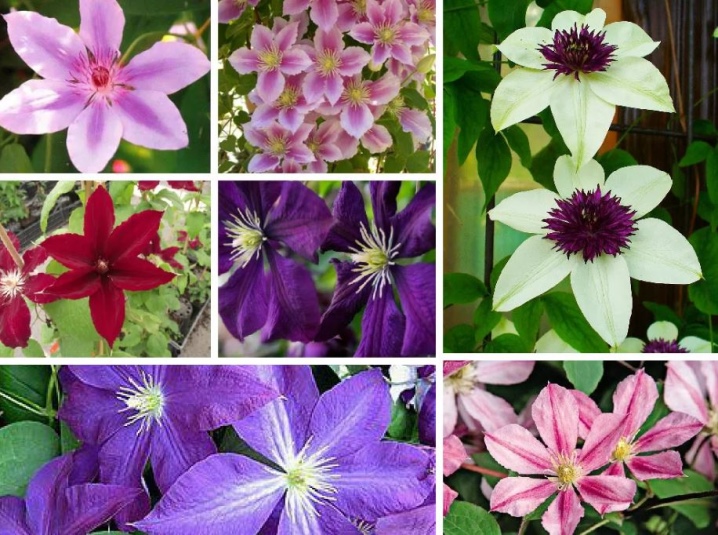
The species diversity of clematis is incredibly large and includes more than 370 plant units. They are usually divided into groups according to the timing of flowering.
- To the 1st group are plants in which flowers are formed on the shoots of the previous year. They bloom from May to June. This category includes alpine, mountain, large-petaled clematis (Macropetala).
These plants are pruned immediately after flowering to stimulate new shoot formation.
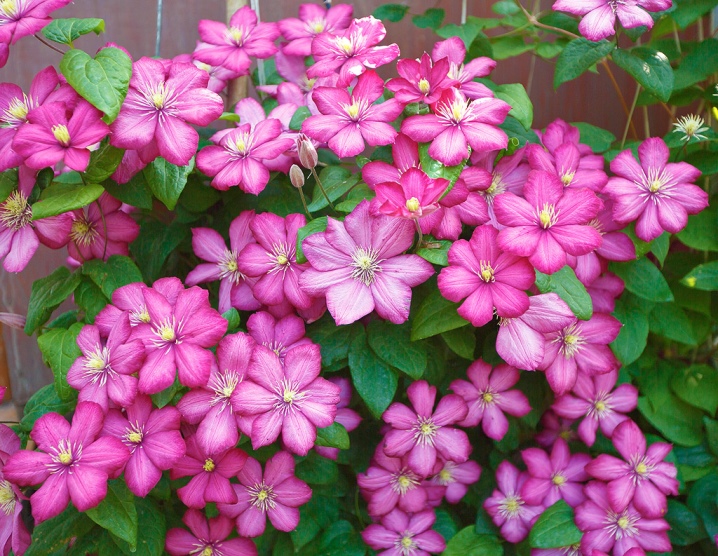
- To the 2nd group Including remontant lianas, blooming first on the shoots of the last year, and by the end of summer re-forming buds on the branches of the new season. This includes almost all hybrid varieties, and the type of their flowering can also differ: the first wave in this case will be terry, the second - with simple inflorescences.
Pruning of these plants is carried out at the end of flowering, the shoots are shortened by 1/2 the length, every 4-5 years they completely eliminate the lashes almost at the root.
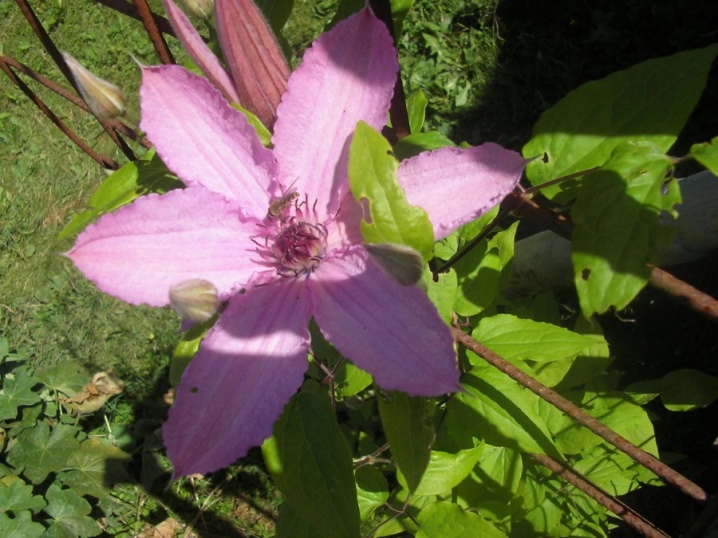
- To the 3rd group are large-flowered hybrid varieties that are characterized by late flowering, beginning in July and August. This includes the serratus, violet (Viticella), oriental and Texen clematis. For clematis of this group, pruning is shown almost at the root, 10-30 cm of vine shoots are left on the surface. Similarly, all herbaceous clematis are prepared for winter.
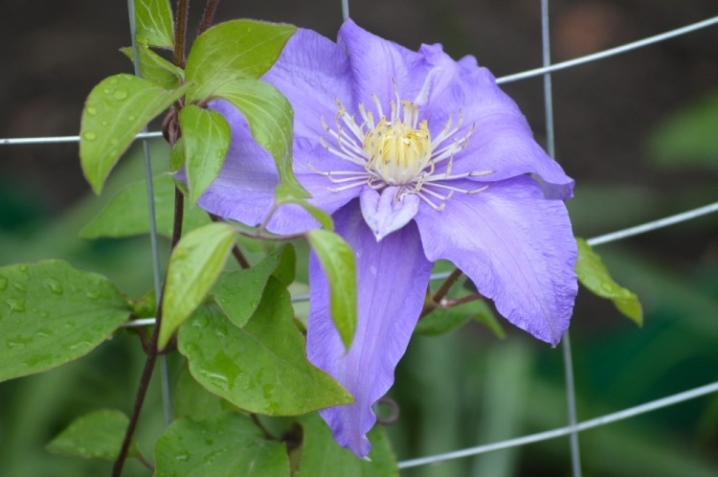
The most popular are the following clematis.
- Tangutsky. Natural form, widespread in Central Asia and China. The woody liana grows up to 3 m, can remain straight or take the form of a vine. The flowers are deep yellow in color, look like unopened bells, very decorative.

- Texensky. The hybrid species with bell-shaped flowers is distinguished by late flowering, purple-violet gamut prevails in the colors. Liana is woody, can reach a height of about 2.5 m.
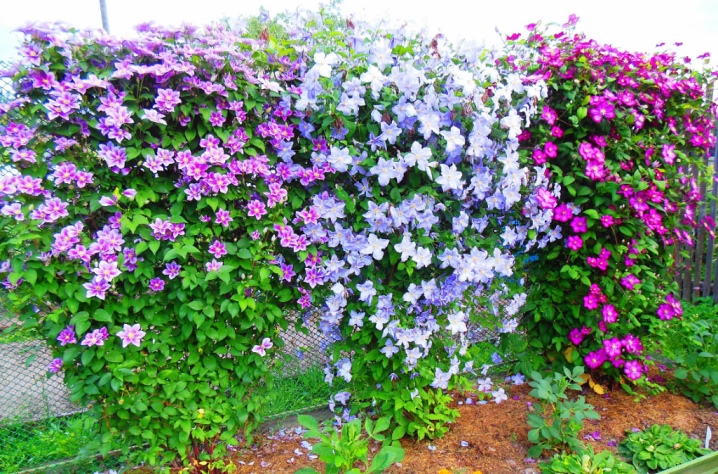
- Oriental. A type of clematis, very common in the European territory of Russia. The flowers are yellow, in the wild, the plant is presented in the form of a shrub, in cultivated forms it looks like a semi-woody liana, capable of braiding supports up to 6 m high.
The plant is remontant, it gives buds twice a season.
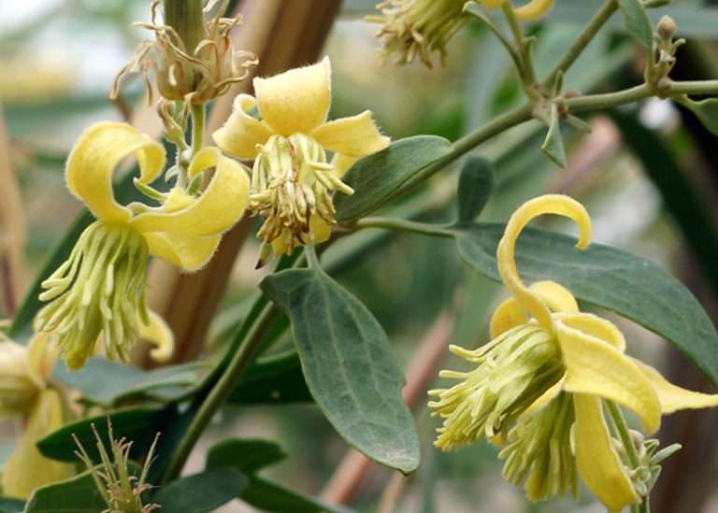
- Ethusoliferous. An East Asian species characterized by a wide double or triple pinnate dissection of the leaves. This species is also characterized by the formation of bell-shaped inflorescences, late flowering. Semi-shrub vines of this type are low in nature, form bushes 20-40 cm long, in cultivated forms they can reach 2 m.
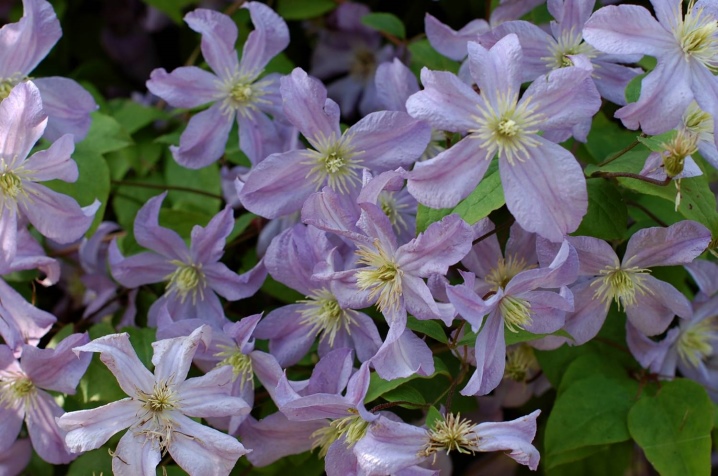
- Serrated-leaved. Clematis, characteristic of the flora of the Far East, can have the appearance of a woody recumbent or climbing liana, reaching a height of 3 m. The flowers are white-yellow in color, with a broad-bell-shaped bowl. The buds are not too abundant.
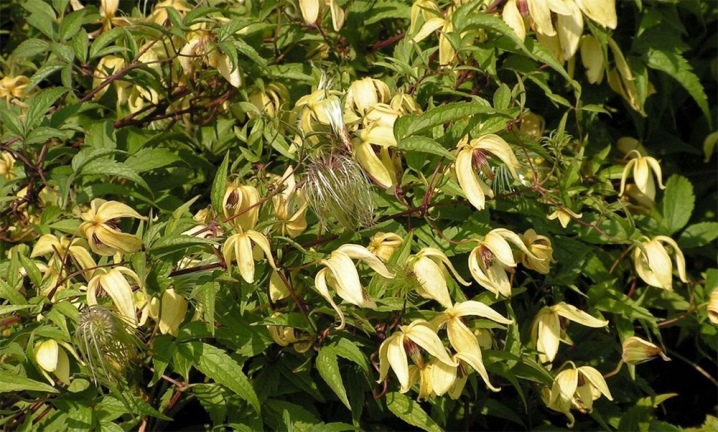
- Grape-leaved. The natural range extends from northern Africa to the Caucasus, the plant is naturalized in the USA and Australia. It belongs to liana-like shrubs, has rather tough stems, and blooms white in June and July.
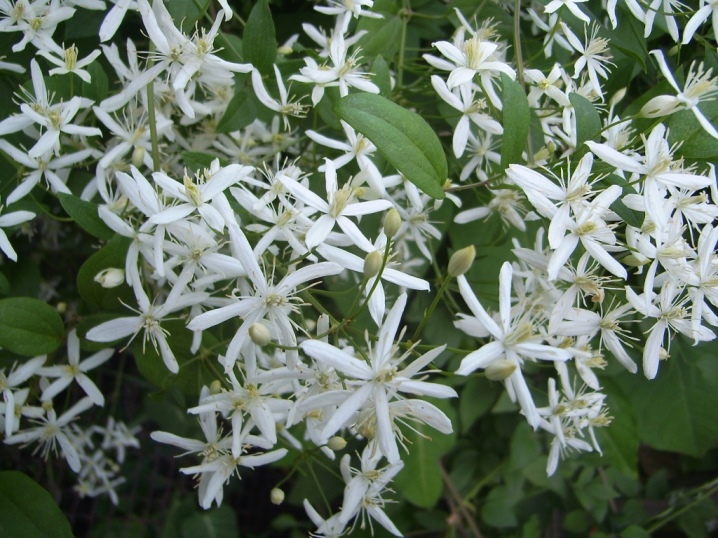
- Burning or scented. The species got its name for its strong smell, its natural habitat is the coast of the warm Black or Mediterranean Sea. The climbing liana has a woody stem, can reach a height of 5 m, flowering later, with white paniculate inflorescences.
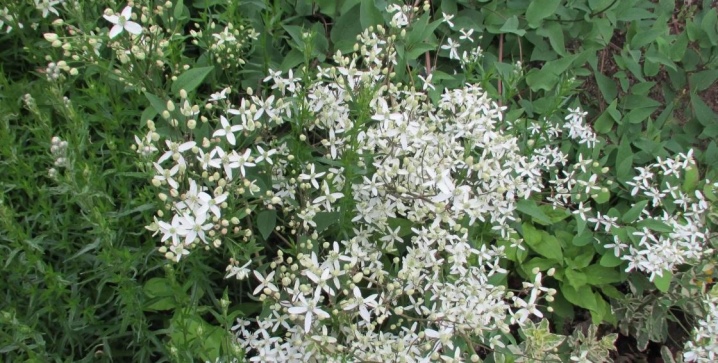
- Alpine. Rather, it belongs to the princes, but belongs to the genus clematis. These clematis have a characteristic bell-shaped inflorescence, growing as a climbing shrub with a small - from 1 to 2 m - height.
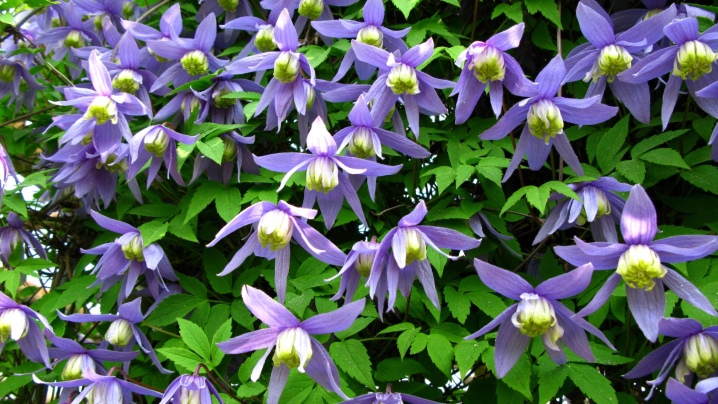
- Purple. The most popular among breeders, the habitat is quite wide - from the southern regions of Eurasia to the North-West of Russia, it is found in Iran and Georgia. Differs in beautiful flowering, forms buds of blue, lilac, pink-violet, purple hues. Liana shrub type grows up to 4 m.
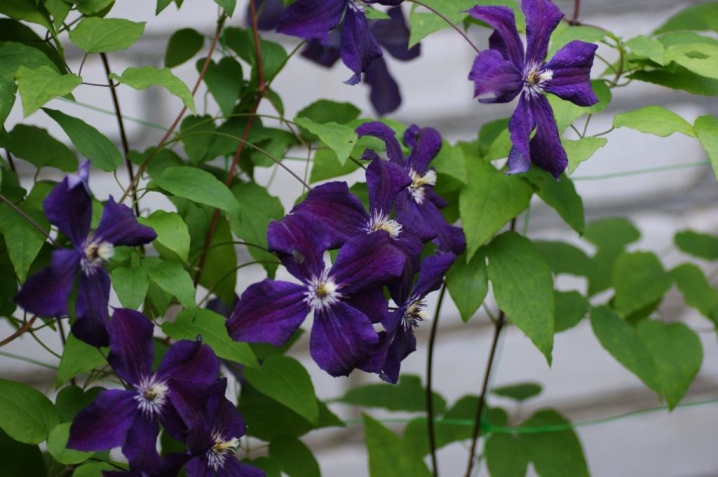
- Mountain. This species is very popular in cultivated breeding in the USA and European countries. A very long woody liana, reaching 8-12 m in length. Flowers have different colors - from white and yellow to red, pink, purple.
The species is distinguished by early flowering.
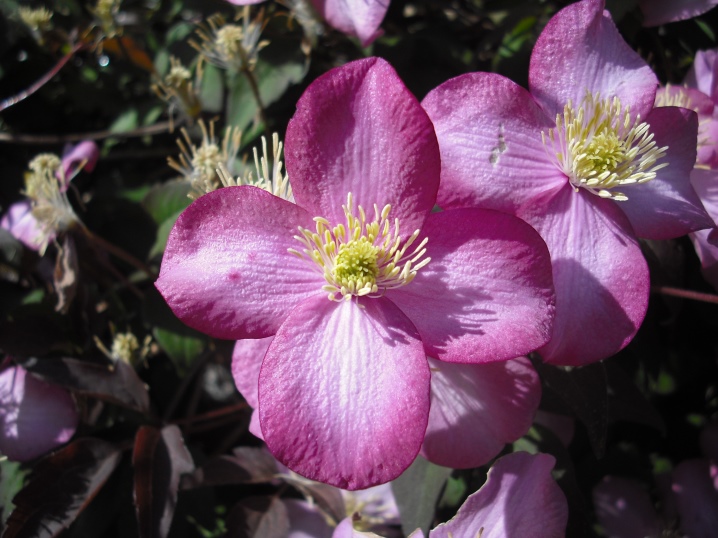
- Woolly or lanuginosis. It grows naturally in China, became the ancestor of many varieties in cultural selection. Liana is woody, has a bare or pubescent stem, grows up to 2-3 m, the plant blooms from July to September with white or lavender flowers.
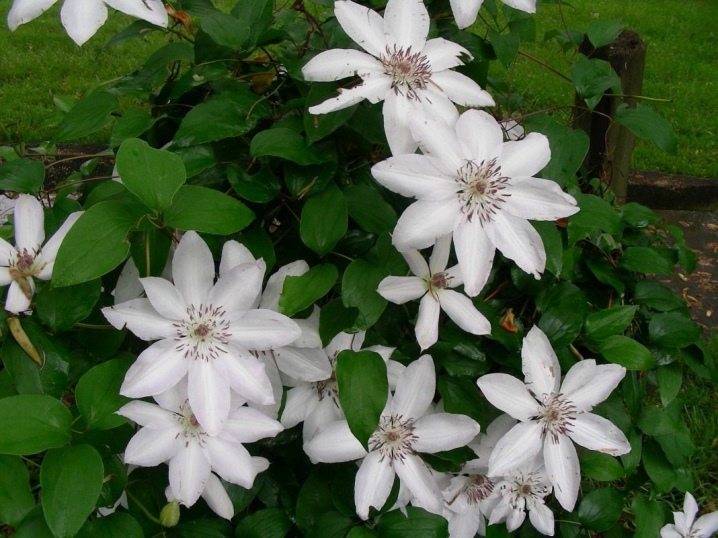
- Zhakman. Quite common in Europe and North America, the species belongs exclusively to cultivated plants, does not occur in nature. Liana grows up to 3 m long and has long flowering. The shade of the buds is from purple to pink.

- Straight. Does not produce vines, grows exclusively straight, is found everywhere in nature, originally grew in the Caucasus and in the mainland of Europe. Flowers are small, abundantly decorate the shrub.
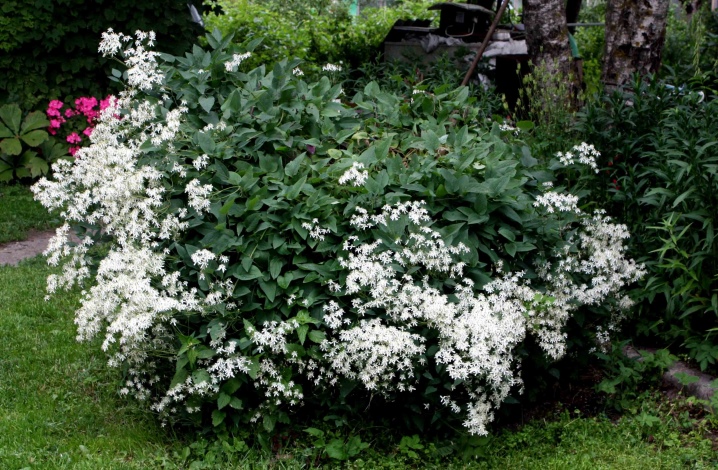
Hybrid Japanese varieties of clematis are quite whimsical, among them there are undersized, slow-growing species. Lianas rarely grow more than 2 m. Japanese clematis strikes with rare colors, among them there are many two-color specimens, blue, purple, salmon-pink specimens with large flowers and a short flowering period prevail.
Shade tolerant
If you want to plant clematis in shady areas, you should from the very beginning choose varieties for which bright sun is contraindicated. These include the following varieties.
- Avangard. It is a bicolor variety with flat lower petals of a bright red hue and a lush, double, light pink bud. A small diameter - about 10 cm - is redeemed by abundant flowering. A distinctive feature of the variety is its long flowering throughout the summer.
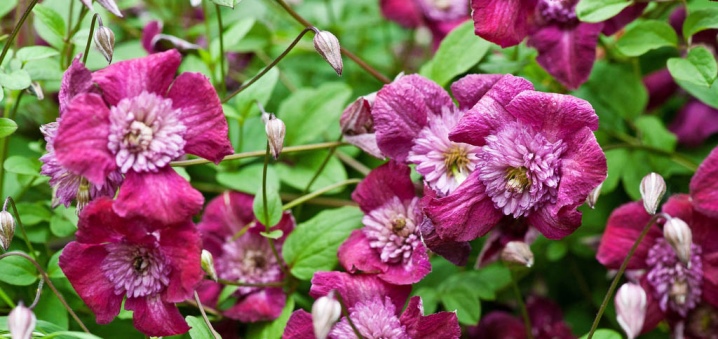
- "Ballerina". One of the most common varieties of white large-flowered clematis is named after Maya Plisetskaya, a hybrid variety has been known since 1967, well adapted to the Russian climate. The vine reaches a length of 3 m, is shortened by half for the winter, and successfully overwinters. Widely popular, unpretentious cultivar with beautiful, long-lasting flowering. In June, the shoots of last year bloom, the young give buds in August.
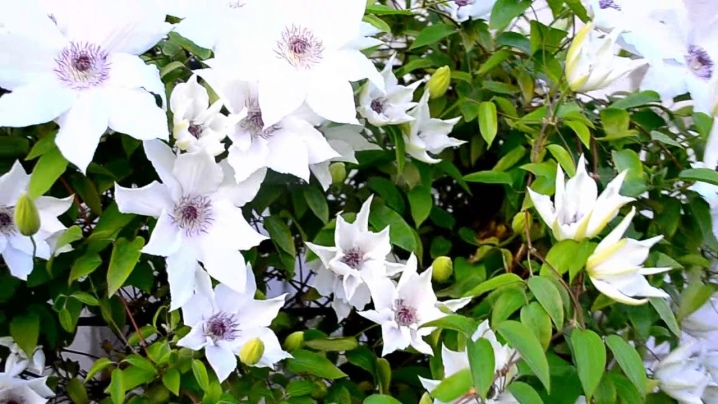
- Gipsy Queen. Clematis, characterized by abundant and long flowering. The purple-violet buds look bright and juicy. The sepal has a velvety surface.
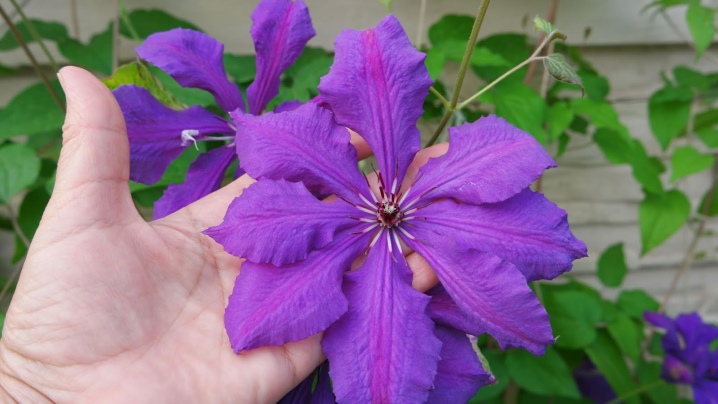
This does not exhaust the list of shade-tolerant varieties and they can be easily selected based on the general concept of garden design.
Frost resistant
Given the climatic features of Russia, when planting clematis in open ground, site owners have to take into account such points as the frost resistance of the variety. Some vines will have to be pruned for the winter, others can hibernate on a trellis without much risk for themselves.
Among the varieties that easily tolerate frosty winters, the following can be distinguished.
- "Cosmic melody". A variety with climbing shoots that grow up to 4 m in length. The plant belongs to the category of shrub vines, blooms profusely with purple flowers with a burgundy tint. Cutting group 3, the buds are formed exclusively on the shoots of the current year. The flowering period is short - in June and July.
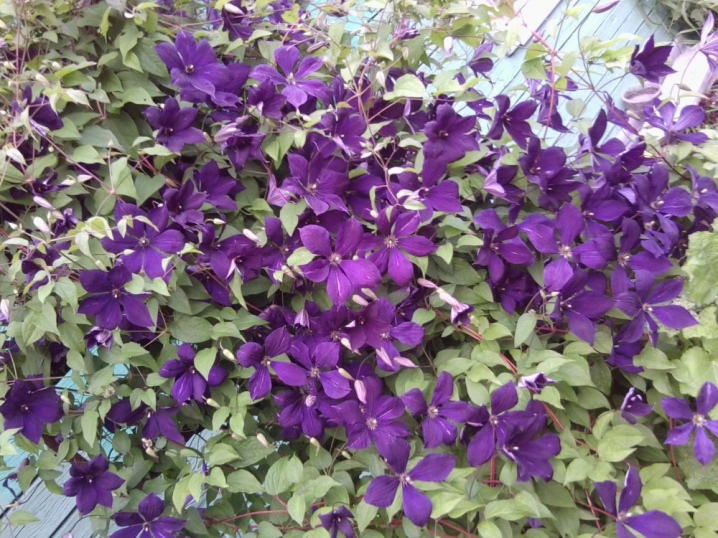
- Nikolay Rubtsov. Named after the famous poet, the variety is distinguished by its incredible brightness and richness of colors. The maximum height of the shoots is 2.5 m, the flowering is long, abundant, with the formation of flowers up to 17 cm in diameter. For the winter, this variety does not need to be cut off, leaving it to winter on a trellis.
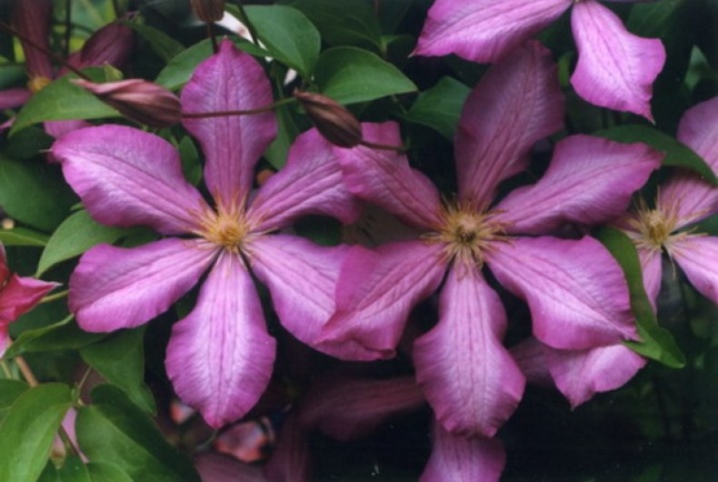
- "Ville de Lyon". One of the most frost-resistant varieties among all clematis. Blooming carmine-red buds lasts from May to September. The flowers are small, about 10 cm in diameter. When preparing creepers for winter, they cut it off without further covering.
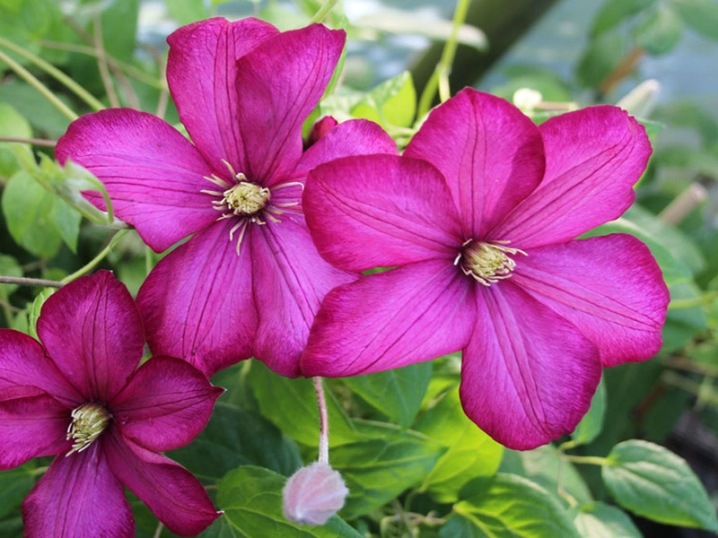
These varieties are able to winter calmly even in conditions of rather severe frosts. But in addition to resistance to low temperatures, it is also worth considering adaptation to a specific climatic zone.
Description of popular varieties
Lomonosov or clematis, in addition to species diversity, are also represented by a huge number of varieties. Breeders breed forms that have incredible flowers (more than 20 cm in diameter). Many hybrids provide long flowering from May to October, are particularly bright in color or delicate aroma.
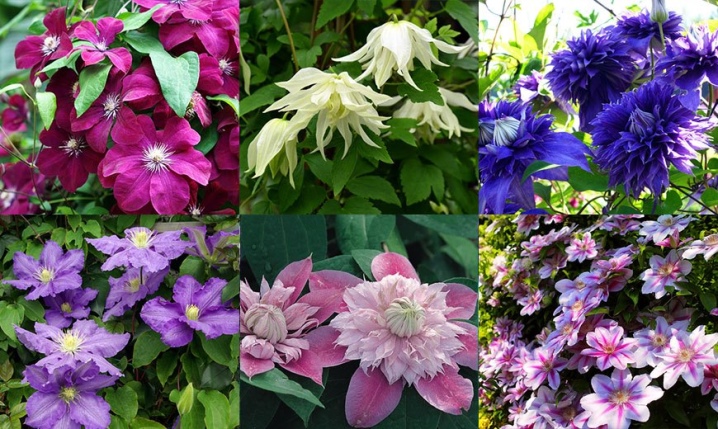
"White cloud"
An excellent ornamental variety, subspecies of burning clematis. The shrub vine is abundantly strewn with flowers and during the growing season it really resembles a hovering cloud. The inflorescences themselves are stellate, small, 2-3 cm in diameter, up to 400 buds can form on 1 shoot. The plant actively grows branching in length and width, braiding the surrounding space by 5 m or more. During flowering, an exquisite honey aroma spreads around the bush.
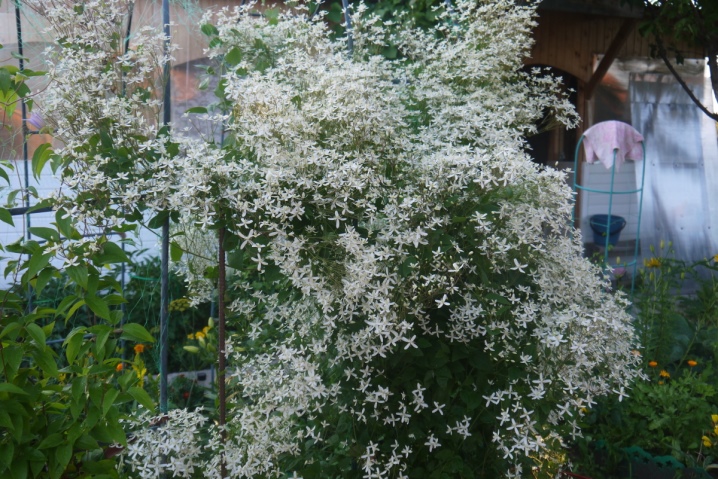
"Alyonushka"
A widespread shrub variety with a climbing form of shoots reaches a height of 1.5-2 m. It blooms with bell-shaped buds, gradually opening, the period of activity is from May to July. Selection variety, bred in the botanical garden of the Crimea. Gardeners in it are primarily attracted by the satin lilac-pink color of the inflorescences, as well as the opportunity to get a green carpet creeping on the ground without support. Clematis "Alyonushka" is suitable for growing in the open field and for planting in pots, flowerpots on balconies and terraces.
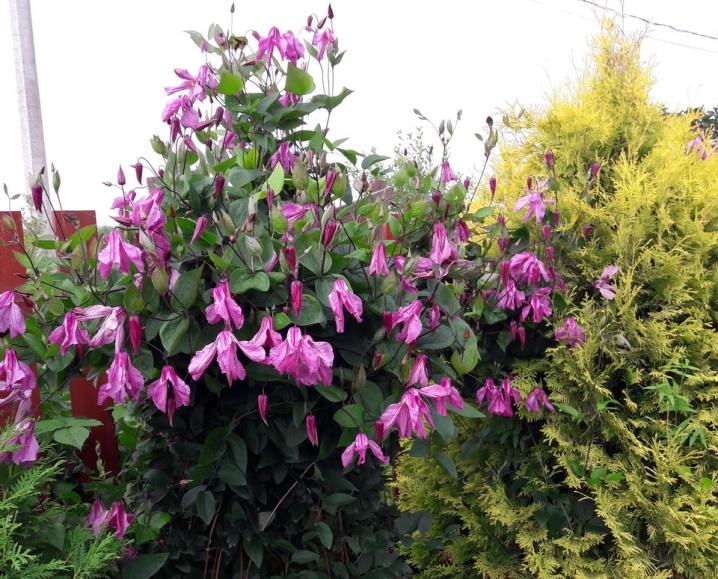
"Asao"
Japanese breeding variety with large expressive flowers. Differs in early flowering, clinging vines, well adhered to supports. The achievable shoot length is 3 m, a remontant variety, in the first wave it can form semi-double or double-type inflorescences. The flowers have a bright pink edging and a lighter central part of the petals; yellow stamens favorably set off a spectacular appearance.
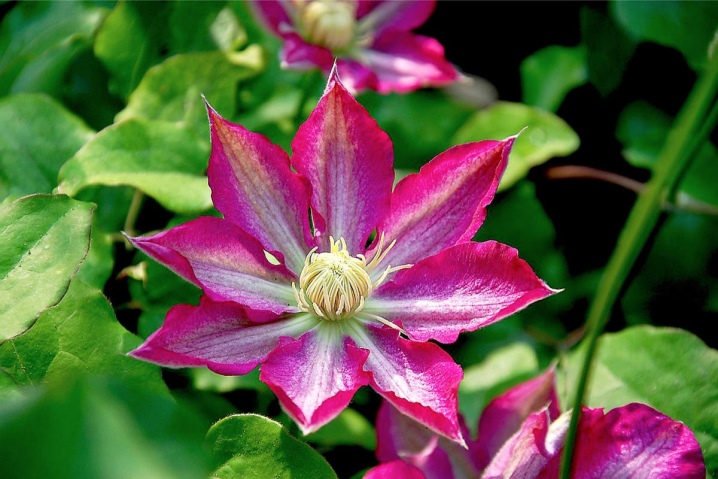
"Akaishi"
Luxurious variety with large pink-purple flowers. Early bloom makes it a desirable garden decoration. Despite the Japanese selection, it is suitable for growing in the climate of the Moscow region... The flowers of the variety are large, up to 15 cm in diameter, there is an expressive light pink border.
Repeated September bloom is possible.
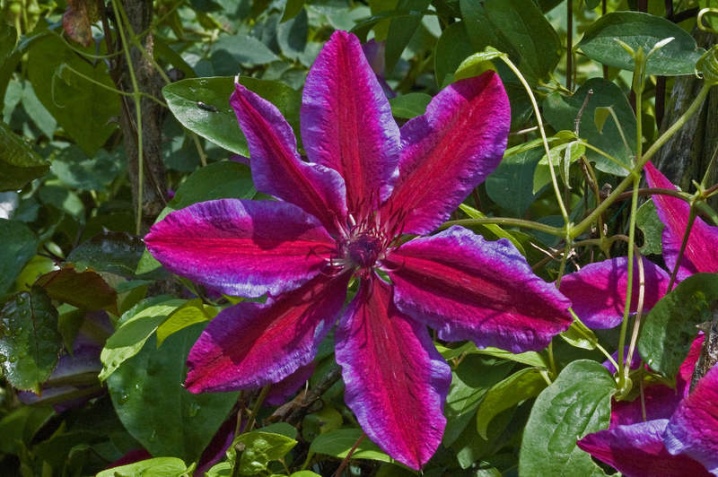
"Proteus"
A splendid shrubby vine that blooms profusely and lushly throughout the summer. The variety is characterized by the doubleness of the first flowers on the shoots of last year and a lilac-lilac color. The bush tolerates wintering well in the Russian climate, is suitable for balcony or terrace growing and looks incredibly decorative.

"Beauty Bride"
An exquisite large-flowered variety with snow-white star-shaped buds. Bred in Poland by the famous breeder Marchiński, it is distinguished by early flowering with a second wave in August. The plant forms shoots up to 3 m long, clinging well to the surface of the trellis. The flowers are of record size - the diameter of the bowl reaches 28 cm.
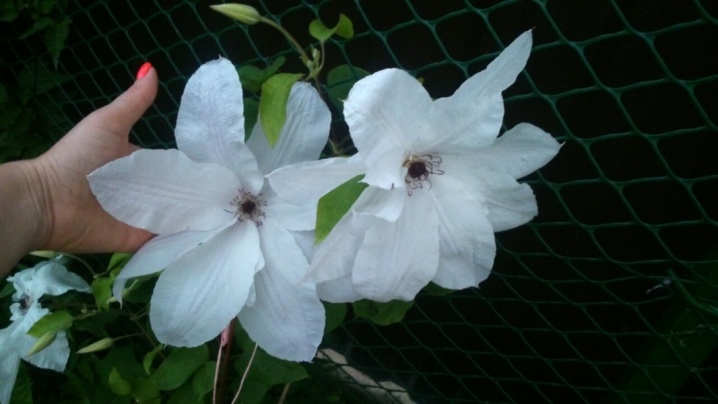
"Polish Spirit"
A popular Polish variety of clematis, easily adapting to growing in different climatic zones. It blooms profusely, with blue-ink or purple-blue buds, inside which there are contrasting orange stamens. The variety is distinguished by long flowering from June to October, has an exquisite leaf shape, well suited for growing on hedges, trellises, and supports of various types. Flowers of medium size, up to 10 cm in diameter, are formed exclusively on the shoots of the current year.
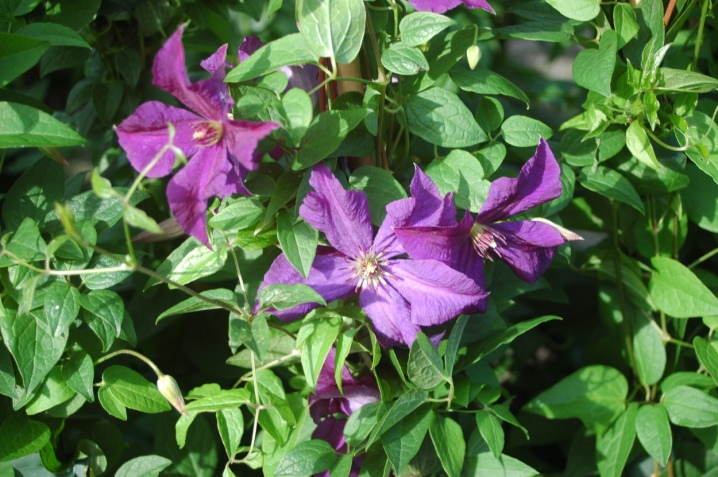
"Daniel Deronda"
A low-growing shrub form of clematis with a shoot height of up to 1.5 m. A hybrid variety of English selection is distinguished by remontant, double flowering. Can produce double and simple bowls, on young shoots of the current year. A distinctive feature of the variety is the inky blue shade of the petals, which looks very impressive in the garden and when grown in pots or flowerpots.
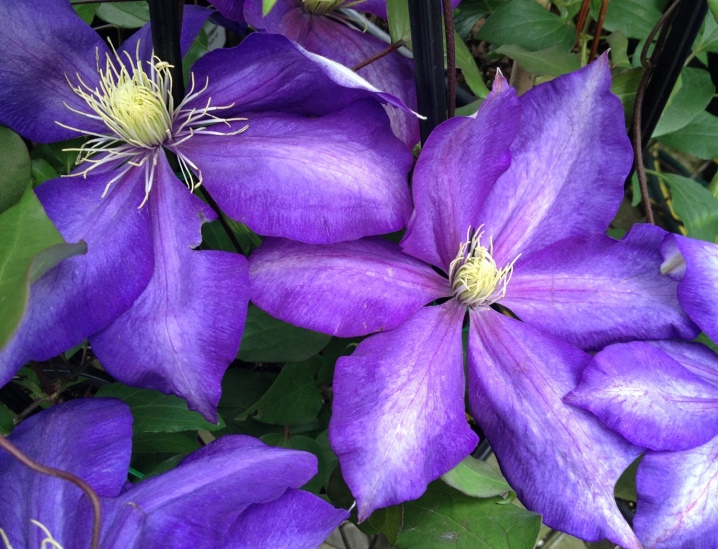
"Blue light"
Blue Light is one of the most popular blue clematis varieties. The plant is characterized by the doubleness of the flowers, they look lush and very decorative. The variety has a rather interesting color, rather blue than bright blue, looks good on trellises or when grown in a container on the balcony. Liana belongs to the species with a short length of lashes, while the flowers themselves reach 15 cm in diameter and look elegant in different types of landscape compositions.
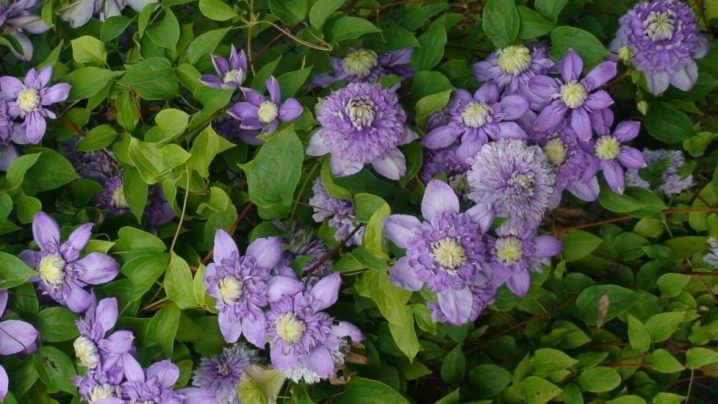
"Blue exploited"
Clematis variety Blue explosion belongs to the category of Polish breeding hybrids. It is considered early flowering, striking in the brightness of blue or blue-purple flowers with a contrasting yellow core. The diameter of the bowl reaches 15 cm, it has a double or semi-double shape. The plant is clinging, the shoots reach 3 m in length.
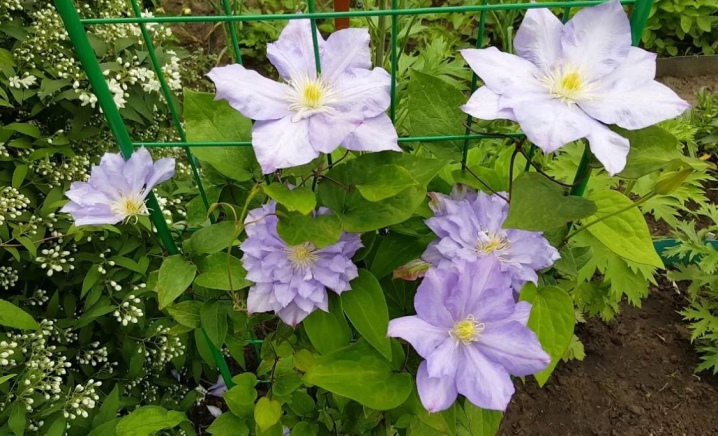
"Kakio"
An upright Japanese variety, also known as Pink Champagne due to its original color - its petals are pink-lilac with a darker and brighter border. On the shoots of the last year, double buds are formed, on the young, variants with a flat bowl are formed. The variety is characterized by very early flowering, tall shoots appear 5-6 years after planting, reaching 2 m.
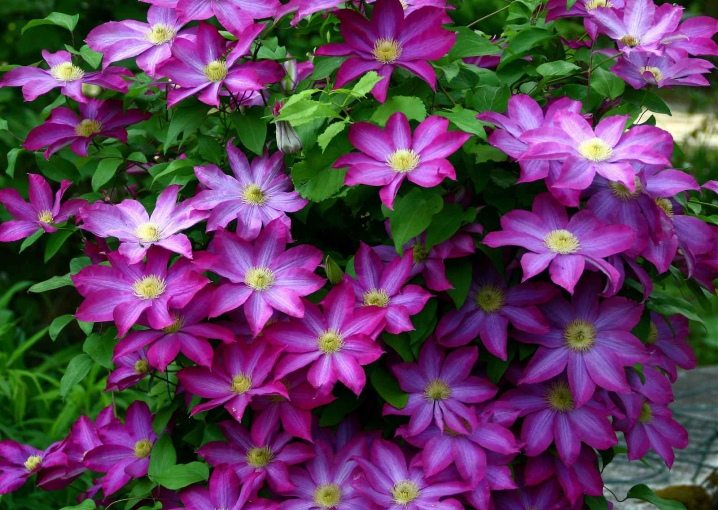
"Cloud"
A hybrid variety of clematis with a rich inky color of flowers, in the center of the petals there is a raspberry strip. The dimensions of the liana are about 2-3 m, the diameter of the inflorescences does not exceed 11 cm. The Russian breeding variety blooms from July to September, feels good when kept on the balcony or in flowerpots on the terrace. It can be used as a ground cover option or as an element of vertical landscaping.
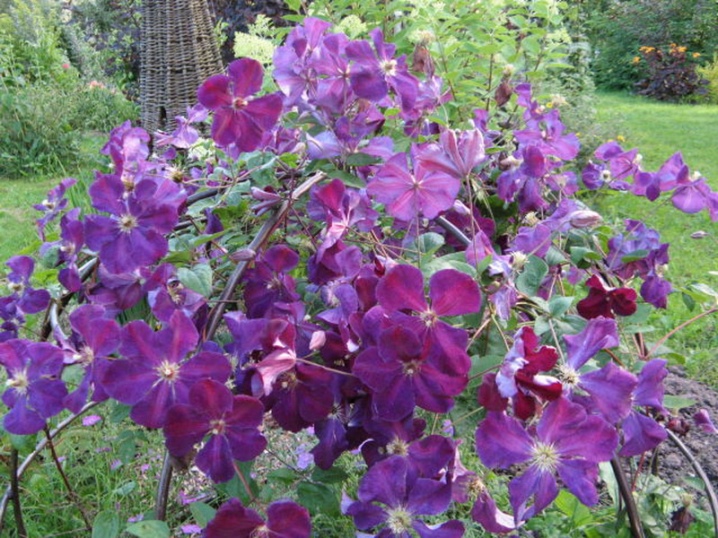
"Prince Charles"
Compact shrub variety, erect, grows up to 1-1.5 m. Clematis forms light blue, with a slight lilac shade, flowers of small diameter, characterized by long and abundant bud formation - from June to late September. The variety is suitable for container cultivation, it is an unpretentious and frost-resistant plant.

"Mrs. Thompson"
The Mrs N. Thompson variety, bred by British breeders in 1961, belongs to the hybrid forms of sprawling clematis, is distinguished by the formation of large flowers. The plant is suitable for use in a variety of conditions - from container growing on the balcony to planting in open ground. Liana grows up to 2.5 m, clings to the supports. The flowers are bright, blue-violet, with a crimson stripe in the center of the petal.
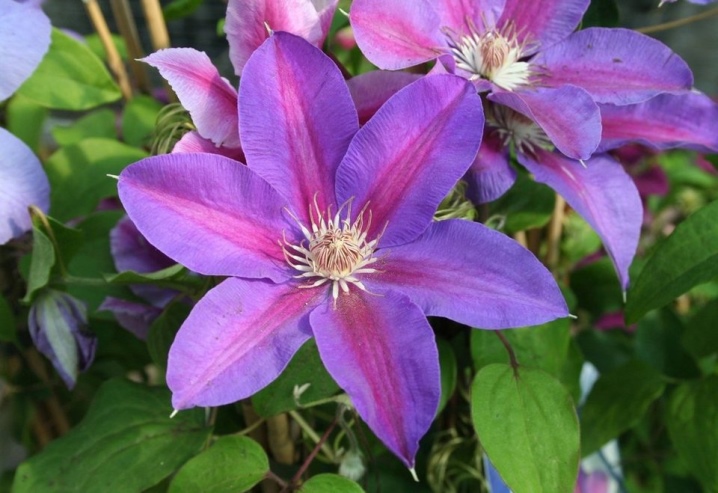
"Mrs. Cholmondeli"
Curly hybrid liana wrapped around the supports. It forms flowers of a rich lilac-purple color, the buds are very abundantly formed throughout the summer against the background of fresh greenery. Liana requires a garter or support, it can reach 3.5 m in length. On the shoots of the second year, the flowers are double.

"Innocent Glance"
The clematis variety Innocent Glance is famous for its large, pale pink flowers, reaching a diameter of 10-15 cm, the shoots grow up to 2 m in length. The breeding work was carried out by Polish specialists. On the shoots of last year, terry inflorescences are formed, lush and decorative. Flowers with single-row petals are formed on young branches.
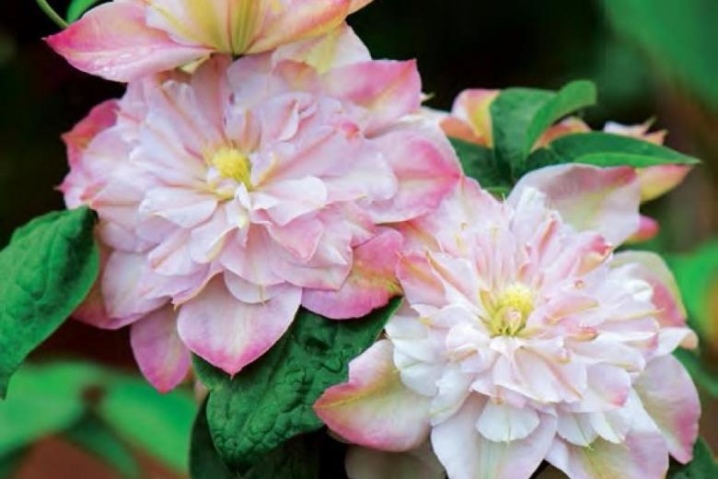
"Princess Kate"
A Dutch variety of clematis, belonging to the group of Texas hybrids. The flowers that form on the bush resemble lilies, have a white-pink shade of petals and a bright base of a rich burgundy-purple hue. The variety is distinguished by abundant and prolonged bud formation from June to September, the vine grows up to 4 m in length, strongly branches, suitable for arches, pergolas.

"Albina Captivity"
Clematis of this variety have long, climbing shoots up to 4 m with a weak vines. The hybrid form was obtained by a Swedish enthusiast, it does not require pruning, and takes root well in the Russian climate. Terry flowers, small diameter, snow-white, are formed in April-May, from June on the branches you can see only beautiful fluffy infructescence.
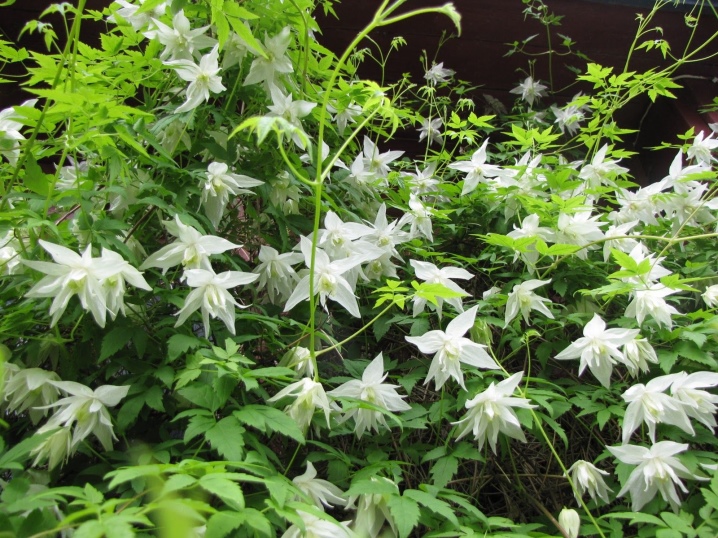
"The Snow Queen"
A popular variety of lianas with shoots up to 3 m long, characterized by early flowering, forms large inflorescences of a snow-white shade with raspberry-pinkish anthers. The flowers are characterized by strong corrugation of the edges, they reach 18 cm in diameter, with the repeated formation of buds in autumn, they may have pink stripes on the surface.

Jensi Cream
An original, profusely flowering clematis variety with simple cream-colored single-row petals and bright yellow stamens. The variety is quite cold resistant, adapted to the Russian winter. Liana reaches 2.5 m in length, flowers have a bowl diameter of up to 15 cm, bud formation lasts throughout the summer.
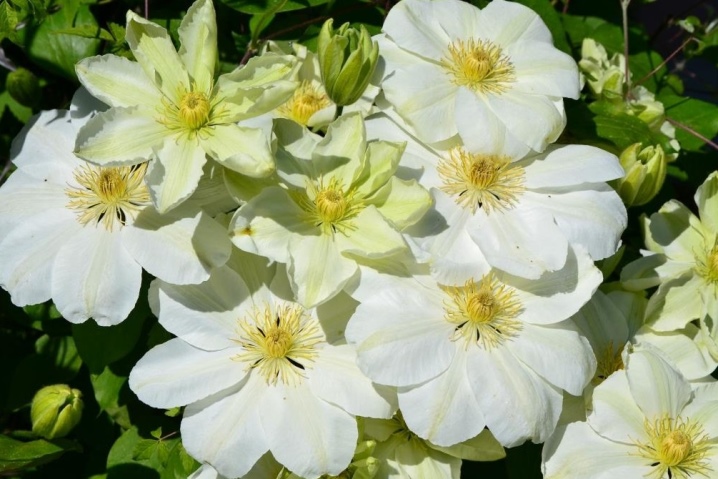
Mary Rose
Densely double clematis of the viticella group, liana grows up to 3 m in length, flowers are formed only on the shoots of the current year. The shade of the petals is amethyst, with a pronounced ash-pearl shade. The variety is not afraid of frost, winters well in the Moscow region.
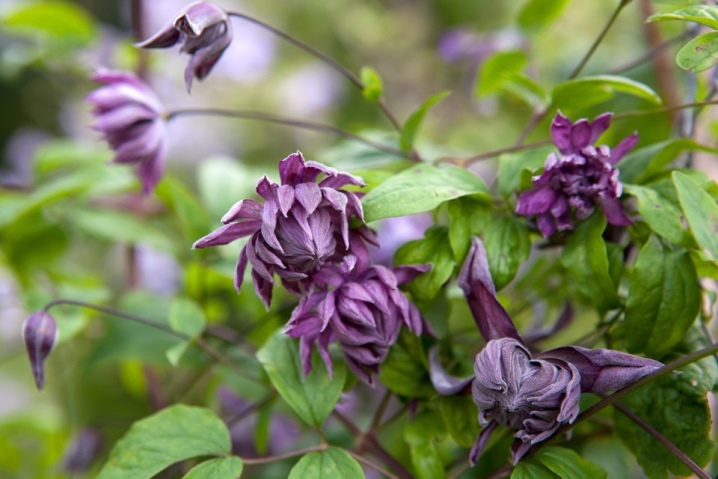
"Tudor"
Dutch pink-violet clematis variety with expressive red-purple veins. Differs in early flowering (in May-June), buds are formed on the shoots of the current year in July-August. The plant is very decorative, unpretentious in the choice of growing conditions.
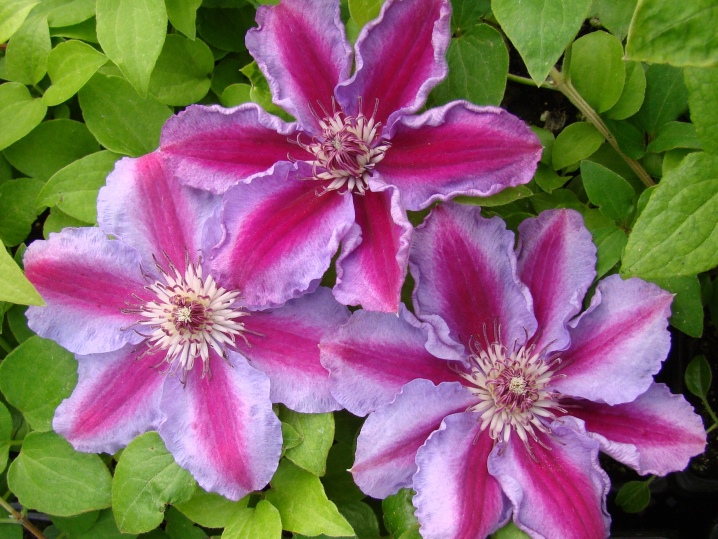
We take into account the terrain
When choosing a variety of clematis for planting, the climatic features of the varieties must be taken into account. So, winter-hardy options are well suited for Siberia and the Urals. For the northwestern part of Russia, shade-tolerant varieties should be considered, since in the Leningrad region and other regions in this direction, the number of sunny days is significantly reduced. For central Russia - from the Moscow region to the Voronezh region - it is better to select varieties that bloom in the summer months.
What clematis are recommended for growing in Siberia? There are no special restrictions on the selection of varieties, early flowering clematis - "Anastasia Anisimova", "Elegy", "Nadezhda" are considered the best options.
It is recommended to plant plants on the southern side of buildings and structures, in a place protected from the wind.

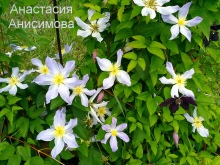
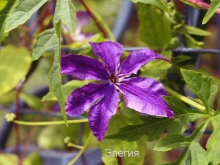
For the Urals, a wider range of clematis can be selected, creating rich and luxurious flower arrangements in landscape design.Shrub species with bell flowers grow well here. Lianas of varieties feel good in the climate of the Urals Nikolay Rubtsov, Ville de Lyon, Elegance.
In the Moscow region, clematis feel good enough, but it is better to choose species that are cold-resistant. It is interesting to look in gardens and parks shrubs with crimson flowering, such as "Gladstone". The remontant varieties "Fair Rosamund" and "Zhanna Dark" are well suited for planting.

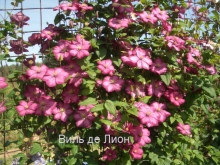
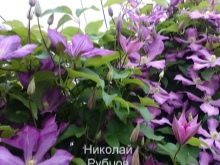
Selection Tips
The range of clematis today is incredibly large. Hundreds of species and varieties are waiting for planting, but how to deal with the selection of the best option for a garden or growing on a balcony? First of all, it is worth focusing on belonging to a certain group of plants. So, the most unpretentious plants for open ground are included in the groups Viticella, Jackmanii, Integrifolia, Atragene. Others will not be suitable for successful wintering without additional shelter.
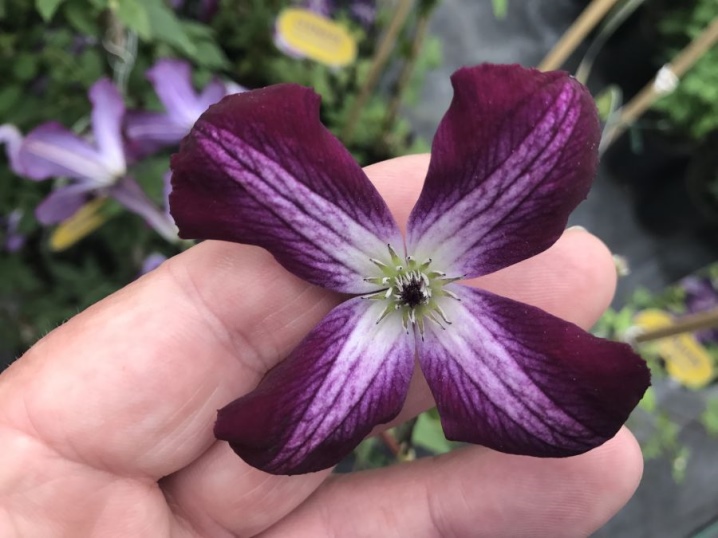
The unpretentious Lanuginosa lianas are also suitable for beginners. Small-flowered bush clematis are quite fragrant and almost do not need complex care or pruning. Only mountain clematis requires winter shelter.
The presence of a shadow on the site also matters. If there is a lack of sun, it is better to pay attention to varieties for which this factor is not particularly important. It is worth paying attention to the type of soil. For example, hybrid and large-flowered varieties of the Integrifolia and Viticella groups grow well on acidic soils. Alkali-rich land is necessary for planting Tangut, Eastern, Alpine and mountain clematis.
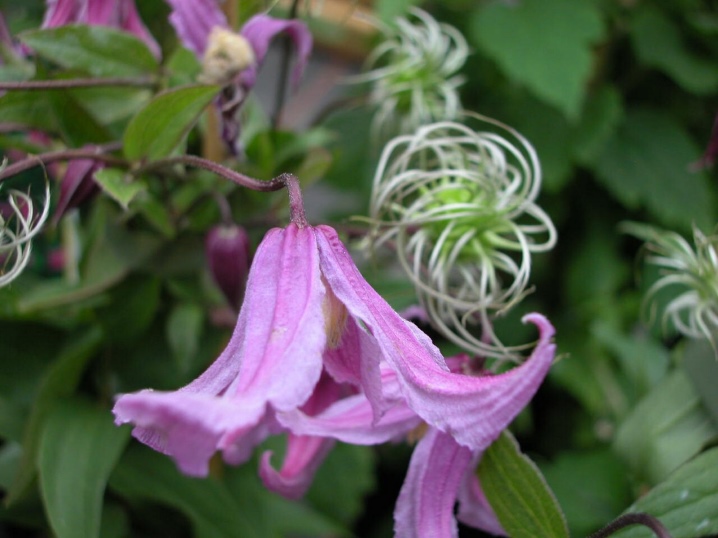
For information on how to properly care for clematis, see the next video.







































































































The comment was sent successfully.